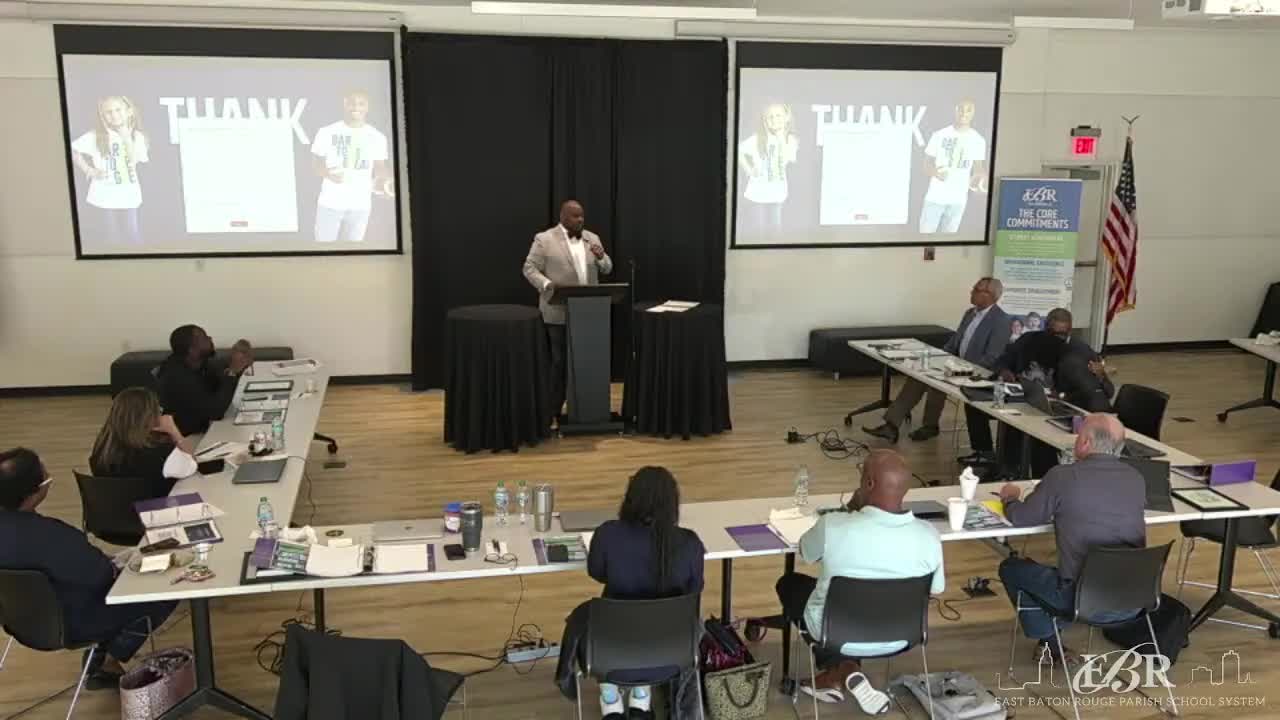District launches facilities master plan process and outlines $40M high‑school bond priorities
November 01, 2025 | East Baton Rouge Parish, School Boards, Louisiana
This article was created by AI summarizing key points discussed. AI makes mistakes, so for full details and context, please refer to the video of the full meeting. Please report any errors so we can fix them. Report an error »

Consultants and district staff outlined a two‑year facilities master‑planning process and a parallel, staff‑led list of proposed high‑school projects tied to a planned $40 million bond initiative.
Pam Whitley, the district’s facilities consultant, described the master plan as a multi‑lane effort: project initiation and governance; current‑state condition and inventory; alternatives analysis for vacant properties; priority setting; and the development of a software‑driven tool for scenario planning. "If not now, when?" Whitley asked, arguing the district should act while momentum and realignment gains are recent and deferred maintenance costs are rising.
CSRS, a long‑time facilities partner, told the board it would update condition assessments, demographic forecasts and prior tax‑plan work and fold LeanFrog and district data into scenario tools. CSRS President Tim Barfield said up‑to‑date facility assessments and demographic studies are necessary before prioritizing capital investments.
High‑school bond projects: Staff summarized standardized requests from all 14 district high schools, collected via school surveys and a scoring rubric (facility need, student impact, sustainability/fiscal dependency, transformative school/community impact). Staff said the school list submitted to the superintendent totals approximately $36 million in preliminary estimates and is being refined; the $40 million bond would be used to address prioritized items across the 14 campuses. The district will sequence work to minimize instructional disruption and will prepare bid packages; staff expect to bring a recommended sequencing and procurement plan to the board in January.
Why it matters: The master plan aims to turn scattered condition data into a living planning tool so the board can run 'what‑if' budget scenarios, set safety and ADA priorities, and plan capital investments with an eye to the district’s strategic goals. Consultants emphasized the need to standardize data (current vendor reports, CSRS assessments, LeanFrog dashboards) and to engage external partners for potential public‑private options on vacant properties.
Next steps: Staff will refine cost estimates, sequence projects to reduce school disruption, and return to the board with recommended procurement steps and a phased work plan. The district also proposed opportunities to visit comparable out‑of‑district examples of public‑private conversions and site reuses to inform decision‑making.
Pam Whitley, the district’s facilities consultant, described the master plan as a multi‑lane effort: project initiation and governance; current‑state condition and inventory; alternatives analysis for vacant properties; priority setting; and the development of a software‑driven tool for scenario planning. "If not now, when?" Whitley asked, arguing the district should act while momentum and realignment gains are recent and deferred maintenance costs are rising.
CSRS, a long‑time facilities partner, told the board it would update condition assessments, demographic forecasts and prior tax‑plan work and fold LeanFrog and district data into scenario tools. CSRS President Tim Barfield said up‑to‑date facility assessments and demographic studies are necessary before prioritizing capital investments.
High‑school bond projects: Staff summarized standardized requests from all 14 district high schools, collected via school surveys and a scoring rubric (facility need, student impact, sustainability/fiscal dependency, transformative school/community impact). Staff said the school list submitted to the superintendent totals approximately $36 million in preliminary estimates and is being refined; the $40 million bond would be used to address prioritized items across the 14 campuses. The district will sequence work to minimize instructional disruption and will prepare bid packages; staff expect to bring a recommended sequencing and procurement plan to the board in January.
Why it matters: The master plan aims to turn scattered condition data into a living planning tool so the board can run 'what‑if' budget scenarios, set safety and ADA priorities, and plan capital investments with an eye to the district’s strategic goals. Consultants emphasized the need to standardize data (current vendor reports, CSRS assessments, LeanFrog dashboards) and to engage external partners for potential public‑private options on vacant properties.
Next steps: Staff will refine cost estimates, sequence projects to reduce school disruption, and return to the board with recommended procurement steps and a phased work plan. The district also proposed opportunities to visit comparable out‑of‑district examples of public‑private conversions and site reuses to inform decision‑making.
Don't Miss a Word: See the Full Meeting!
Go beyond summaries. Unlock every video, transcript, and key insight with a Founder Membership.
✓
Get instant access to full meeting videos
✓
Search and clip any phrase from complete transcripts
✓
Receive AI-powered summaries & custom alerts
✓
Enjoy lifetime, unrestricted access to government data
30-day money-back guarantee

